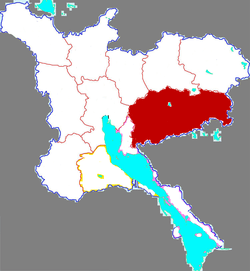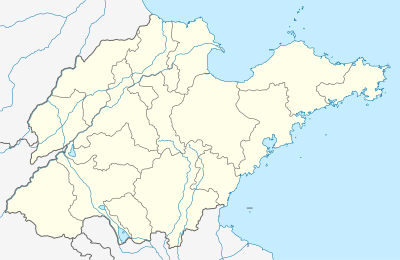Zoucheng
Zoucheng (simplified Chinese: 邹城; traditional Chinese: 鄒城; pinyin: Zōuchéng) is a county-level city in the south of Shandong province, China. Before it became a city, it was known as Zou County or Zouxian.[1]
Zoucheng 邹城市 | |
|---|---|
A Zoucheng landscape | |
 Zoucheng in Jining | |
 Zoucheng Location of the city center in Shandong | |
| Coordinates: 35°24′11″N 117°00′25″E | |
| Country | People's Republic of China |
| Province | Shandong |
| Prefecture-level city | Jining |
| Area | |
| • County-level city | 1,619 km2 (625 sq mi) |
| • Urban | 1,619 km2 (625 sq mi) |
| • Metro | 1,619 km2 (625 sq mi) |
| Population (2010 census) | |
| • County-level city | 1,116,692 |
| • Urban | 1,116,692 |
| • Urban density | 690/km2 (1,800/sq mi) |
| • Metro | 1,116,692 |
| • Metro density | 690/km2 (1,800/sq mi) |
| Time zone | UTC+8 (China Standard) |
| Website | www |
Zoucheng is located about 20 km south of the city of Qufu, and like Qufu, is administratively under the prefecture-level city of Jining. Its population was 1,116,692 at the 2010 census even though its built-up (or metro) area is much smaller.
Administrative divisions
Thirteen towns:
Historical sites
The philosopher Mencius was born in Zoucheng, then within the feudal State of Zou. His descendants lived in Zoucheng all the way to the present. Some of them migrated to Taiwan after the Chinese Civil War. In the present day, there are four major sites in the city relating to Mencius: the Mencius Temple (simplified Chinese: 孟庙; traditional Chinese: 孟廟; pinyin: Mèng Miào), the Mencius Family Mansion (孟府; Mèng Fǔ), the Mencius Forest (孟林; Mèng Lín, 35°28′42.27″N 117°2′56.11″E), and Mencius' Mother's Forest (孟母林; Mèng Mǔ Lín, 35°29′29.97″N 116°58′49.09″E).
The Mencius Temple, which covers an area of more than 4 hectares (9.9 acres) on the south side of town, has five courtyards and sixty-four halls and rooms. Its history dates back to the year 1037 in the Northern Song dynasty.[5] The Mencius Mansion, where his descendants lived, is adjacent to the temple, and has 116 halls and rooms.[6]
According to the management of the Mencius Temple, the temple grounds house over 270 stone steles and sculptures, some of which dating from as early as the Song dynasty.[7] Among them are some Yuan dynasty stelae with inscriptions in 'Phags-pa script.[8]
Immediately to the north of Zoucheng lies the tomb of the King of Lu of the Ming dynasty (明鲁王墓). It is the tomb of Zhu Tan (1370-1389), the tenth son of the Hongwu Emperor of the Ming dynasty. There is also a royal tomb from the Han dynasty (汉鲁王墓).
 Mencius Temple
Mencius Temple Chongxing Pagoda
Chongxing Pagoda Inscriptions on precipices of Tieshan
Inscriptions on precipices of Tieshan
Transportation
References
- Legge, James (1867). Confucius and the Chinese classics. A. Roman. pp. 379–384. - Rev. A. Williamson's account of his visit to Zoucheng (Tsou-hien, or Tsiu-hien, in his transcription) and the Temple of Mencius in 1865
- 邹城市历史沿革 [Zoucheng City Historical Development] (in Chinese). XZQH.org. 27 January 2014. Retrieved 26 June 2018.
2008年,撤销平阳寺镇,并入太平镇。调整后,全市辖3个街道、13个镇:钢山街道、千泉街道、凫山街道、香城镇、城前镇、大束镇、北宿镇、中心店镇、唐村镇、太平镇、石墙镇、峄山镇、看庄镇、张庄镇、田黄镇、郭里镇。
- 2016年统计用区划代码和城乡划分代码:邹城市 [2016 Statistical Area Numbers and Rural-Urban Area Numbers: Zoucheng City]. National Bureau of Statistics of the People's Republic of China. 2016. Retrieved 26 June 2018.
统计用区划代码 名称 370883001000 钢山街道办事处 370883002000 千泉街道办事处 370883003000 凫山街道办事处 370883101000 香城镇 370883102000 城前镇 370883103000 大束镇 370883104000 北宿镇 370883105000 中心店镇 370883106000 唐村镇 370883107000 太平镇 370883109000 石墙镇 370883110000 峄山镇 370883111000 看庄镇 370883112000 张庄镇 370883113000 田黄镇 370883114000 郭里镇
- 邹城政务网 [Zoucheng Government Affairs]. 邹城政务网 (in Chinese). Zoucheng People's Government. Retrieved 26 June 2018.
镇园区网站 邹城市中心店镇 邹城市郭里镇 邹城市看庄镇 邹城市石墙镇 邹城市北宿镇 邹城市城前镇 邹城市大束镇 邹城市峄山镇 邹城市凫山街道 邹城市张庄镇 邹城市千泉街道 邹城市田黄镇 邹城市香城镇 邹城市钢山街道 邹城市太平镇 邹城市唐村镇
- "Mengzi Temple". China Travel Tour Guide. Retrieved 31 July 2010.
- "Mengzi Mansion". China Travel Tour Guide. Retrieved 31 July 2010.
- Overview of steles at the Temple of Mencius, placard on site.
- 孟子故里文化典藏丛书之五《孟庙孟府孟林》. chinamengzi.net. December 2007.
| Wikimedia Commons has media related to Zoucheng. |
External links
- Zoucheng municipal website (in Chinese)